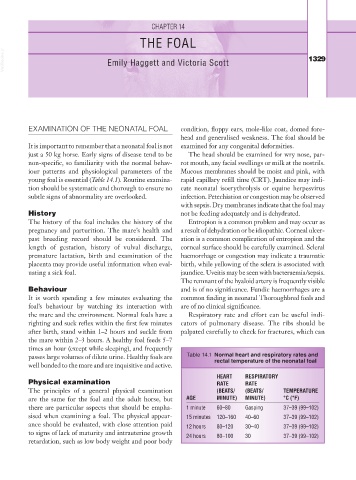Page 1354 - Equine Clinical Medicine, Surgery and Reproduction, 2nd Edition
P. 1354
CHAPTER 14
THE FOAL
VetBooks.ir Emily Haggett and Victoria Scott 1329
EXAMINATION OF THE NEONATAL FOAL condition, floppy ears, mole-like coat, domed fore-
head and generalised weakness. The foal should be
It is important to remember that a neonatal foal is not examined for any congenital deformities.
just a 50 kg horse. Early signs of disease tend to be The head should be examined for wry nose, par-
non-specific, so familiarity with the normal behav- rot mouth, any facial swellings or milk at the nostrils.
iour patterns and physiological parameters of the Mucous membranes should be moist and pink, with
young foal is essential (Table 14.1). Routine examina- rapid capillary refill time (CRT). Jaundice may indi-
tion should be systematic and thorough to ensure no cate neonatal isoerythrolysis or equine herpesvirus
subtle signs of abnormality are overlooked. infection. Petechiation or congestion may be observed
with sepsis. Dry membranes indicate that the foal may
History not be feeding adequately and is dehydrated.
The history of the foal includes the history of the Entropion is a common problem and may occur as
pregnancy and parturition. The mare’s health and a result of dehydration or be idiopathic. Corneal ulcer-
past breeding record should be considered. The ation is a common complication of entropion and the
length of gestation, history of vulval discharge, corneal surface should be carefully examined. Scleral
premature lactation, birth and examination of the haemorrhage or congestion may indicate a traumatic
placenta may provide useful information when eval- birth, while yellowing of the sclera is associated with
uating a sick foal. jaundice. Uveitis may be seen with bacteraemia/sepsis.
The remnant of the hyaloid artery is frequently visible
Behaviour and is of no significance. Fundic haemorrhages are a
It is worth spending a few minutes evaluating the common finding in neonatal Thoroughbred foals and
foal’s behaviour by watching its interaction with are of no clinical significance.
the mare and the environment. Normal foals have a Respiratory rate and effort can be useful indi-
righting and suck reflex within the first few minutes cators of pulmonary disease. The ribs should be
after birth, stand within 1–2 hours and suckle from palpated carefully to check for fractures, which can
the mare within 2–3 hours. A healthy foal feeds 5–7
times an hour (except while sleeping), and frequently
passes large volumes of dilute urine. Healthy foals are Table 14.1 Normal heart and respiratory rates and
well bonded to the mare and are inquisitive and active. rectal temperature of the neonatal foal
HEART RESPIRATORY
Physical examination RATE RATE
The principles of a general physical examination (BEATS/ (BEATS/ TEMPERATURE
are the same for the foal and the adult horse, but AGE MINUTE) MINUTE) °C (°F)
there are particular aspects that should be empha- 1 minute 60–80 Gasping 37–39 (99–102)
sised when examining a foal. The physical appear- 15 minutes 120–160 40–60 37–39 (99–102)
ance should be evaluated, with close attention paid 12 hours 80–120 30–40 37–39 (99–102)
to signs of lack of maturity and intrauterine growth 24 hours 80–100 30 37–39 (99–102)
retardation, such as low body weight and poor body

